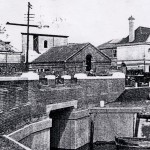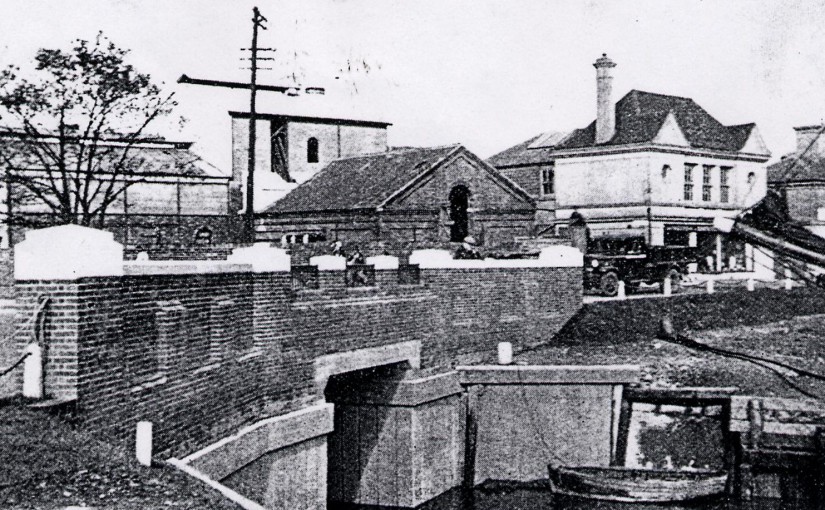By Arthur Woodgate
It was astonishing that anyone should suggest that gas was not made in Rye, but only stored. IT gave me the thought, however, that the strand in Rye had changed during the 20th Century and was worth recording.
I have seen it go from sailing ships to motor bikes and petrol and diesel powered yachts.
I suppose, the first change of the first change was the introduction of the iron hauls of the steam trawlers Kent Colebrooke and Alfred Colebrooke and the third one Margaret Colebrooke which was blown up during the first World War. They used to birth by St Margarets Terrace.
There was an enclosed coal store close by, Now gone to allow for road alterations, the old road used to twist around the stand, inland of the Warehouses and mills. The present road between quay and the warehouses was just a rough piece of ground with footpath running by the coal store, so Capt.> Page, one time skipper of a steam trawler, could no longer retail coal from there. Mr Colebrooke was a famous strand personalities, at the start of the century and by 1913 was the Mayor of Rye, as well as his shipping activity he established a mineral water factory the when it all came about he was at the height of his prime in no time at all in some of his property on the strand. He used the type of bottle that was sealed with a marble, and he had moulded into the glass a picture of one of his fishing fleet, RX1 Goldie.
When the steam trawlers were getting into the new (20th) Century of 1900 my recollection of the river was the decaying carcass of the fishing smack “Pert” RX181 which had been its glory, together with some 50 other smacks over the 19th and 20th Century change.
She laid on her side on the West bank at the gas works end, we youngsters used to play in and around her until a Mr. Firrell broke her up for firewood. So there we had next to her the Marine Engineer workshop of Mr. Alf Gall, giving us the 100 years of ship propulsion through wind, steam and internal combustion.
With the steam trawlers at their moorings and several sea going barges, unloading cargos of around 200 tons each, of basic slag, cement, timber etc. and above all coal it was a busy strip of water. On one occasion a load of bricks were brought in from Belgium, and dumped on the Quay side. The then borough Surveyor. Mr. A J Cornner condemned them from being used on any Rye property. He was right, of course, because they remained there and became a lump of pink dust. Most products were wheeled across planks and into the warehouses. Coal was unloaded in the same way for retail use, onto both the west and east banks, but most was wheeled into the Gas Works. Gang planks were not used only to bridge across the water, but were also placed on the road to make it easier for the men to push five Cwt of coal in wheelbarrows into the gas works coal store. The traffic just had to slow down and jump the planks, but there wasn’t very much motor traffic then. Very hard work, but before 1928 the Kettle of Fish big window was a solid wall with a plinth about a foot up from the pavement. Men would squat on the plinth hoping for an unloading job. Those who were engaged on timber boats; to my mind had the hardest jobs of all the work undertaken by the old Ryers along the banks of the Tillingham, between the Brede sluice and the Tillingham sluice. They had to wear very thick shoulder pads and the two long lengths of wood would whip up and down as they tried to keep in step as they crossed a jumping gang plank on their way to dump their load on a stack on the deals. Isn’t it a pity that the names of The Deals and Havelock Villas were not included in the new buildings on The Deals, but modern developments are interested in only one thing “Money”.
Back to the Gas works I have documentary evidence that the Rye Gas and Coke Company was there in 1892 (no north sea gas then) and I have pictures showing the retort buildings, what is more, I know the stokers in the 1920s. Very friendly men, some of whose names I remember well. Arthur Devonshire, Ernie Jago, and Alf Case not only made the gas they were responsible for pulling on the street lights. At the times of year, when lighting up time came when schools were turning out for the day, we Mermaid Street Boys who lived in the Strand area, would race down Mermaid Street, across Kitty Corner, on to the Wharf, along in front of the deals and Havelock villas and into the stokers cabin. The first boy there would be given the hooked stick and allowed to go round town and pull on the lights. It was inevitable, that in the scramble that some of us should fall over and this seemed to amuse Mr. Devonshire. When he saw blood running down our knees and he would wave a piece of rag as we went by. At other times we would play our way home, along the Strand with out nipcap balls or what ever else we had to hand. One afternoon Geof Gladwish and I were kicking a ball around when a sudden crash told us our ball had broken a window. Our two fathers got together and decided that the five shillings would be paid for by our one penny a week given us for pocket money, so we had no sweets for thirty weeks.
During and just after the first World War, when coal gas was being used to drive motor vehicles there was a tap on top of the gas works wall (about where the brick boat is now). The East Kent Road car company was just getting under way and their buses used to come and fill their big gas balloons on their roofs. If we lads hung about the drivers would give us a ride to their garage by the foundry. David Paine (letter in Rye Observer 07/05/04) was lucky to earn pocket money for picking out coke from the slag from the retorts. My Victorian minded father used to take sixpence and a big sack into the gas office and I had to go from school and put as much coke in the sack as I could and father would pick it up on his way home from work. No extra pocket money. In 1928 The gas Monopoly was threatened, as in moved the giant cable drums of the Electricity Company, many of which were temporary stored on the strand, an army of men pulled cables through replace pipes. The gas company realising they now had serious competition had a hole cut in their road side wall to put in a shop front, to show off their latest gas appliances. At 15 years of age, I spent many days helping punch through that brick wall with 2.5 Ib club hammer and chisel and I can still feel the pain in my shoulders and arms when I think about it now.
From Rye’s Own August 2004
All articles, photographs and drawings on this web site are World Copyright Protected. No reproduction for publication without prior arrangement.
